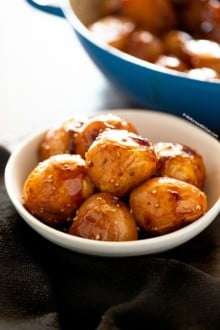The most comprehensive and authentic Japchae (Korean glass noodle stir fry) recipe!
What is Japchae
Japchae or chapchae (잡채) is a very popular Korean dish. It is the number one sought after dish particularly during the Korean festive holidays (e.g. New Year’s day and Harvest festival) but it is also enjoyed on any other common day as well.
Japchae translates as mixed vegetables. When it was first invented in the 17th century, japchae was a noodle-less dish.
But nowadays, the main highlight of the dish is glass noodles, which is made from sweet potatoes, along with colorful vegetables and well seasoned meat.
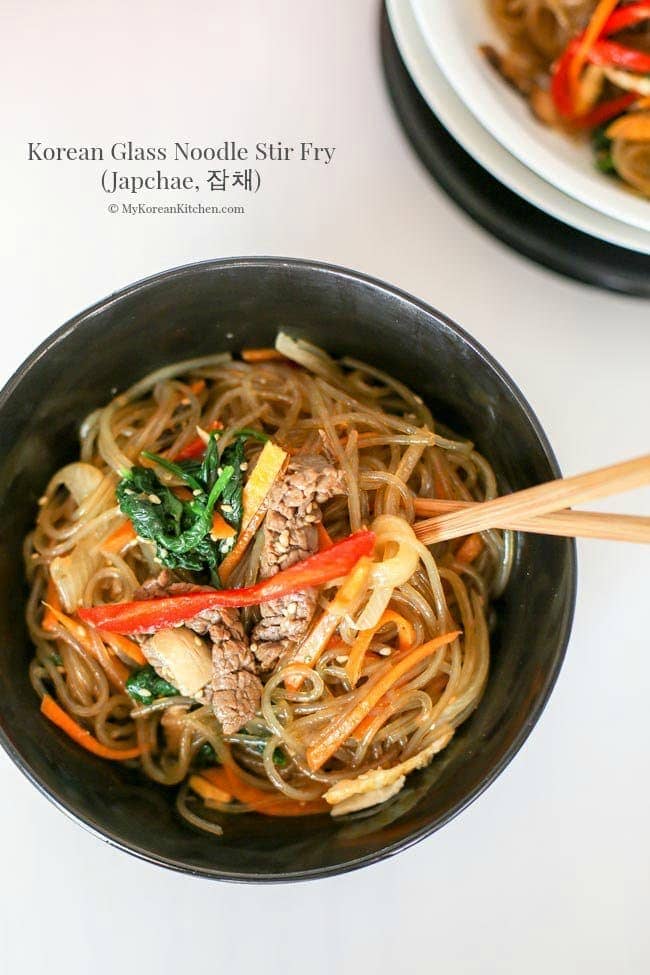
Japchae is typically served as a side dish but it can also be served on a bed of rice (i.e. Japchae-bap, 잡채밥) as a main dish. In this case, I normally serve it with Korean black bean sauce, just like a Korean-Chinese restaurant in Korea. – I will cover that variation at some other time.
Preparing for Japchae is a lot like making bibimbap. It typically requires meat and vegetables (unless you make a vegetarian version) and they are individually prepared and cooked.
Some might argue that this separate cooking process is unnecessary. (I hear you! It’s cumbersome!)
But by cooking them separately you can enhance their individual flavor, texture and color better. (This is really true. I had many mediocre / failed Japchae dishes by stir frying it all at the same time before). After all, they all have a different cooking point.
Well made Japchae should have a balanced sweet and savory flavor, crunchy vegetable texture (not too raw and not too soft) and bouncy noodle texture (not mushy).
And, I’m very happy to share my well made Japchae recipe today! We just couldn’t get enough of it. 🙂 I hope you enjoy my recipe as much as we did!
Ingredients for Japchae (6 to 8 servings)
Main
- 250g / 8.8 ounces Korean sweet potato starch noodles (dangmyeon,당면)
- 100g / 3.5 ounces rib eye fillet, cut into strips
- 1 carrots (120g / 4.2 ounces), rinsed, peeled & julienned
- 110g / 3.9 ounces baby spinach, rinsed
- 1/4 red capsicum / bell pepper (50g / 1.8 ounces), rinsed & julienned
- 1/2 yellow onion (105g / 3.7 ounces) – peeled, rinsed & thinly sliced
- 100g / 3.5 ounces fresh shiitake mushroom – cleaned, stems removed & thinly sliced
Spinach Seasoning
- 1/4 tsp fine sea salt
- 1/2 tsp minced garlic
- 1 tsp toasted sesame oil
Beef Marinade
- 1 Tbsp soy sauce
- 1 tsp rice wine (mirin)
- 1/2 tsp minced garlic
- 1/4 tsp ground black pepper
- 1 tsp toasted sesame oil
Noodles & Mushroom Marinade – Mix these in a small bowl
- 4 Tbsp soy sauce
- 1 Tbsp honey
- 1 Tbsp brown sugar
- 1 Tbsp toasted sesame oil
- 1/8 tsp ground black pepper
Finishing Touch
- 1 Tbsp toasted sesame seeds
- 1 Tbsp toasted sesame oil
- (Optional) 1 extra large egg – rinsed, egg white and yolk separated
Other
- cooking oil – I used rice bran oil.
- fine sea salt
- water to boil the spinach and the noodles
* 1 Tbsp = 15ml
** If you’re not sure of the above Korean cooking ingredients, check my essential Korean cooking ingredients list!
How to Make Japchae
1. Place the beef strips into a medium bowl. Add the “beef marinade” and gently mix the sauce into the meat. Cover the bowl with food wrap and set it aside while you’re working on other ingredients.

2. Get the rest of ingredients ready per below.
- Prepare the vegetables as instructed in the “main ingredients” section.
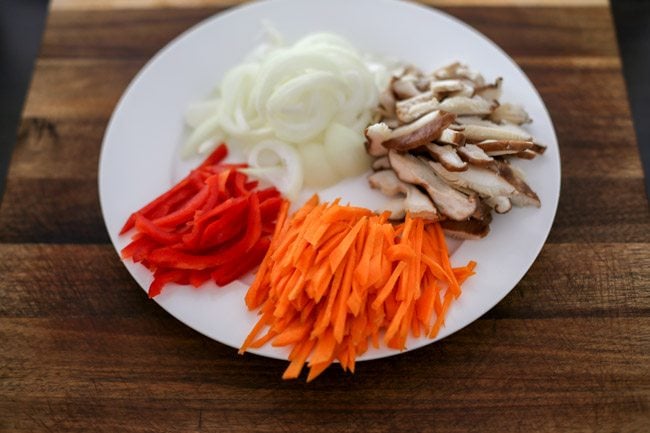
- Put the sliced mushroom into a medium bowl and add 1 Tbsp of “noodles & mushroom marinade” mixture. Mix them well. Set it aside until you cook it (in about 20 mins).
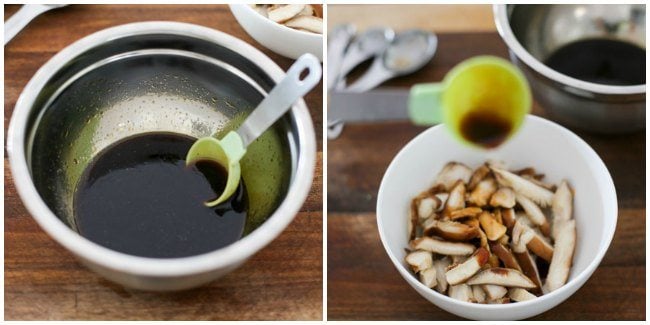
- Blanch the spinach in rolling boiling water (5 to 10 seconds). Drain the water and quickly cool it down by running it under cold tap water. Squeeze the spinach to remove any excess water and put it into a mixing bowl.
Add the “spinach seasoning” and mix them gently and evenly. Put it into a large mixing bowl where we will be adding the rest of the prepared ingredients in later.

- Boil some water in a large pot. Once the water starts to boil (6 to 8 mins later), add the noodles and boil them for 6 to 7 mins. Drain the water. Rinse in cold water to cool down and let the water drain for 1 to 2 mins.
Cut the noodles with a pair of kitchen scissors a couple of times. (Between 15 to 20 cm / 6 to 8 inches length is good). Move the noodles into a mixing bowl and pour in the rest of the “noodles & mushroom marinade” mixture. Mix them well. Set it aside until you cook it (in about 10 mins).
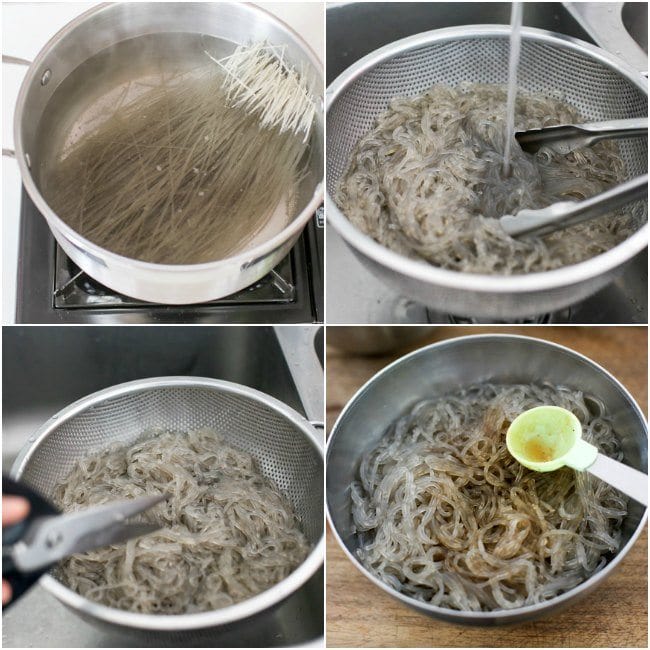
3. Start cooking the prepared ingredients per below. Follow the order if you can. We are cooking lighter color to darker color (to minimize the color transfer and avoid washing up in between) and will be using only one non-stick pan/skillet.
Once each step is completed, move them into the large mixing bowl (except for the first two – egg white and egg yolk), where we will be mixing all ingredients in before serving.
- Beat the egg white with a fork. Add some cooking oil (1 tsp) on a well heated pan and spread it well. Pour the egg white mixture and cook both sides on low heat (1-2 mins). Transfer it onto a clean cutting board and set aside.
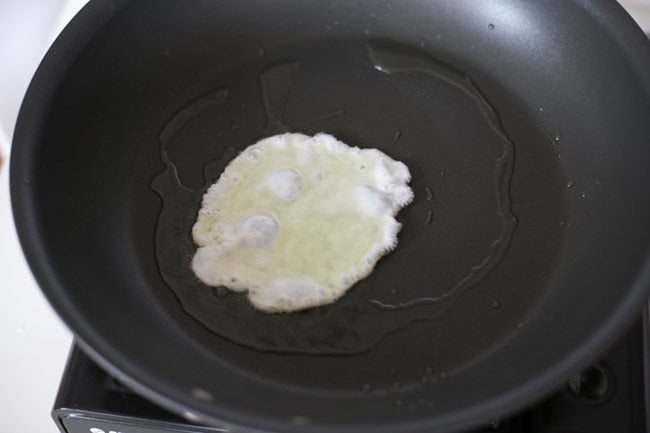
- Beat the egg yolk with a fork. (If necessary, add more cooking oil onto the pan and spread it well.) Pour the egg yolk mixture and cook both sides on low heat (1-2 mins). Transfer it onto a clean cutting board and set aside.
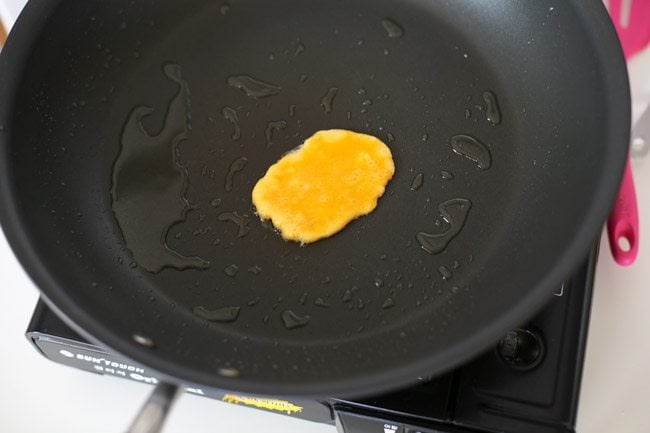
- Add more oil if necessary. Cook the onion with a pinch of salt over low to medium heat until it softens (1-2 mins). Transfer it to the large mixing bowl.

- Add more oil if necessary. Cook the carrots with a pinch of salt over medium heat until it softens (1-2 mins). Transfer it to the large mixing bowl.
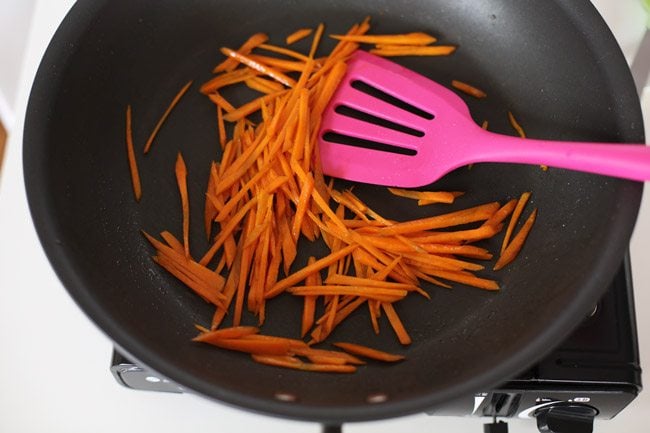
- Add more oil if necessary. Cook the red capsicum with a pinch of salt over low to medium heat until it softens (1-2 mins). Transfer it to the large mixing bowl.
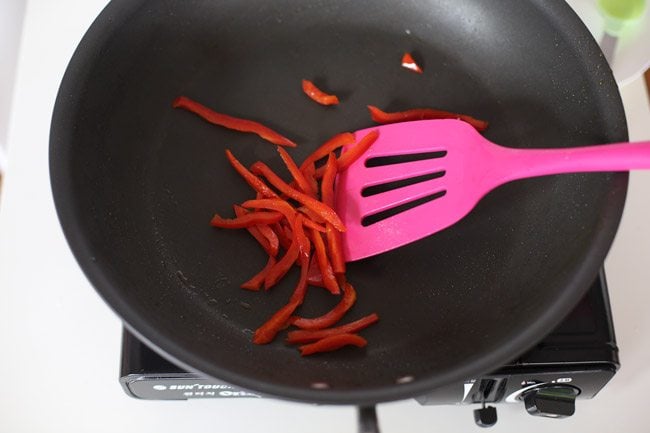
- Add more oil if necessary. Pour in the marinated mushroom (incl. the residue sauce from the bowl) and stir fry until it is cooked (1-2 mins) over low to medium heat. Transfer it to the large mixing bowl.
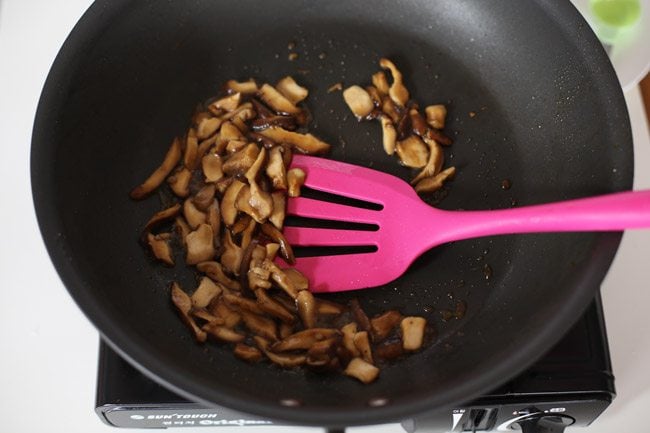
- Add more oil if necessary. Pour in the marinated meat and stir fry until it is cooked (2-3 mins) over medium heat. Transfer it to the large mixing bowl.

- Add more oil if necessary. Stir fry the marinated noodles until the noodles are well coated with the sauce (2-3 mins) over low to medium heat. Transfer it to the large mixing bowl.
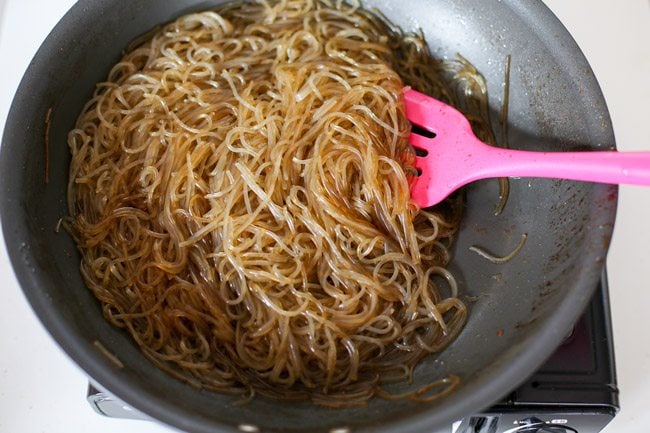
4. Thinly slice the egg white and egg yolk like match sticks. Add them into the large mixing bowl as used above.
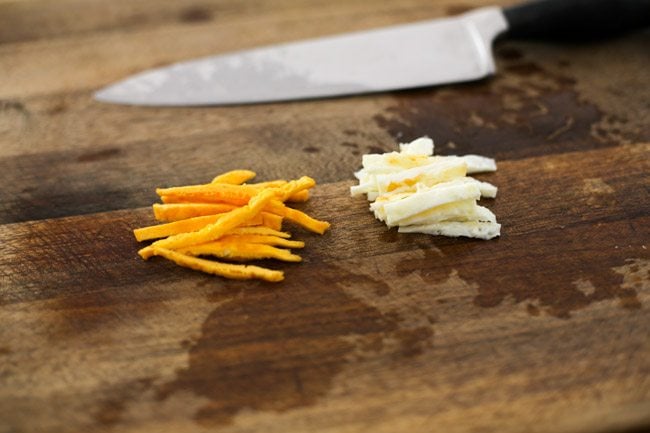
5. Add the rest of the “finishing touch” ingredients – sesame oil and sesame seeds into the large mixing bowl and gently mix them around with your hands.
(Watch your hands, as the ingredients, particularly the noodles might be still hot. You can also use a salad server to mix initially then mix with your hands once it cools down enough.)
Serve and enjoy!
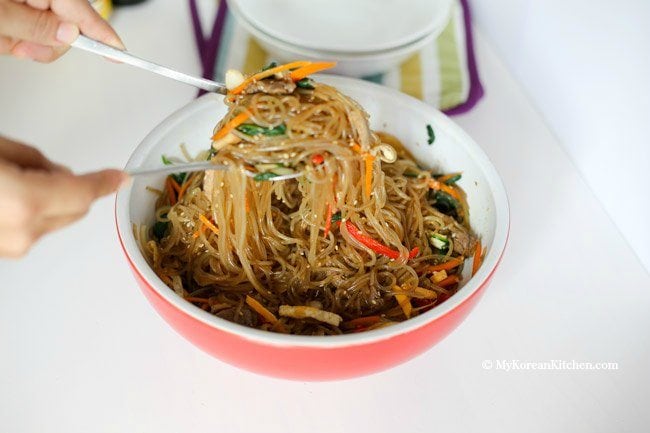
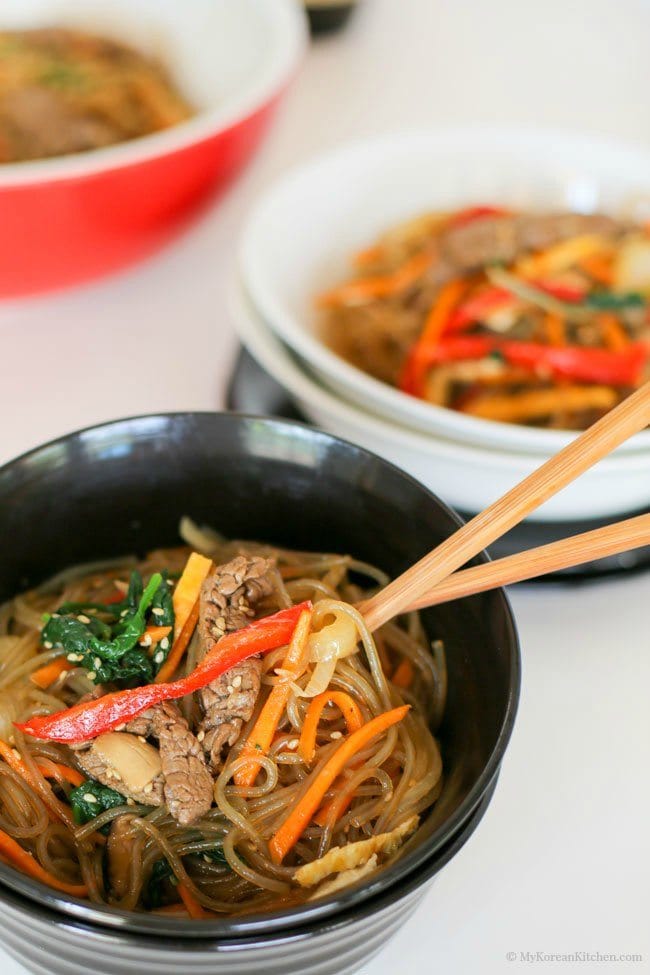
Tips
- If you buy dried shiitake mushrooms instead of fresh mushroom, you will have to soak them in water for a few hours before using them. If you can’t find shiitake mushrooms, oyster mushrooms can be a good substitute.
- I used pre-cut noodles (자른 당면) that are 30-40 cm (12 – 16 inches) long individually. I still cut a bit with my scissors after boiling them but a lot less than if I was using more traditional noodles. In general, these pre-cut noodles are much easier to cook with, so I highly recommend it.
- The best way to save time in preparing and cooking for Japchae is to familiarise yourself with the instructions above and multi-task (e.g. boil two pots of water for spinach and glass noodles at the same time).
- Japchae can be served hot or cold. You can also microwave it to reheat when necessary.
- Japchae can be stored in the fridge for 1-2 days in an air tight container. It can be stored for a bit longer but the noodles don’t look as good by then.
Love Korean food? Browse my other Korean recipes from here. And subscribe to my newsletter and follow along on Facebook, Pinterest and Instagram for all of the latest updates.
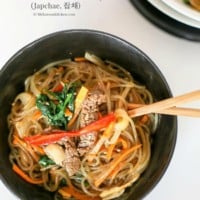
Japchae (Korean Glass Noodle Stir Fry)
Ingredients
MAIN
- 250 g Korean sweet potato starch noodles (8.8 ounces, dangmyeon)
- 100 g rib eye fillet (3.5 ounces), cut into strips
- 1 carrot (120g / 4.2 ounces), rinsed, peeled & julienned
- 110 g baby spinach (3.9 ounces), rinsed
- 1/4 red capsicum (bell pepper, 50g), rinsed & julienned
- 1/2 yellow onion (105g), peeled, rinsed, & thinly sliced
- 100 g fresh shiitake mushroom , cleaned, stems removed & thinly sliced
SPINACH SEASONING
- 1/4 tsp fine sea salt
- 1/2 tsp minced garlic
- 1 tsp toasted sesame oil
BEEF MARINADE
NOODLES & MUSHROOM MARINADE – MIX THESE IN A SMALL BOWL
- 4 Tbsp soy sauce
- 1 Tbsp honey
- 1 Tbsp brown sugar
- 1 Tbsp toasted sesame oil
- 1/8 tsp ground black pepper
FINISHING TOUCH
- 1 Tbsp toasted sesame seeds
- 1 Tbsp toasted sesame oil
- 1 egg (extra large, Optional) rinsed, egg white and yolk separated
OTHER
- cooking oil (I used rice bran oil)
- fine sea salt
- water to boil the spinach and the noodles
Instructions
- Place the beef strips into a medium bowl. Add the "beef marinade" and gently mix the sauce into the meat. Cover the bowl with food wrap and set it aside while you're working on other ingredients.
- Get the rest of the ingredients ready per below.
- Prepare the vegetables as instructed in the “main ingredients” section.
- Put the sliced mushroom into a medium bowl and add 1 Tbsp of “noodles & mushroom marinade” mixture. Mix them well. Set it aside until you cook it (in about 20 mins).
- Blanch the spinach in rolling boiling water (5 to 10 seconds). Drain the water and quickly cool it down by running it under cold tap water. Squeeze the spinach to remove any excess water and put it into a mixing bowl. Add the "spinach seasoning" and mix them gently and evenly. Put it into a large mixing bowl where we will be adding the rest of prepared ingredients in later.- Boil some water in a large pot. Once the water starts to boil (6 to 8 mins later), add the noodles and boil them for 6 to 7 mins. Drain the water. Rinse in cold water to cool down and let the water drain for 1 to 2 mins.Cut the noodles with a pair of kitchen scissors a couple of times. (Between 15 to 20 cm / 6 to 8 inches length is good). Move the noodles into a mixing bowl and pour in the rest of the "noodles & mushroom marinade" mixture. Mix them well. Set it aside until you cook it (in about 10 mins). - Start cooking the prepared ingredients per below. Follow the order if you can. We are cooking lighter color to darker color (to minimize the color transfer and avoid washing up in between) and will be using only one non-stick pan/skillet.Once each step is completed, move them into the large mixing bowl (except for the first two – egg white and egg yolk), where we will be mixing all ingredients in before serving.- Beat the egg white with a fork. Add some cooking oil (1 tsp) on a well heated pan and spread it well. Pour the egg white mixture and cook both sides on low heat (1-2 mins). Transfer it onto a clean cutting board and set aside.- Beat the egg yolk with a fork. (If necessary, add more cooking oil onto the pan and spread it well.) Pour the egg yolk mixture and cook both sides on low heat (1-2 mins). Transfer it onto a clean cutting board and set aside.- Add more oil if necessary. Cook the onion with a pinch of salt over low to medium heat until it softens (1-2 mins). Transfer it to the large mixing bowl.- Add more oil if necessary. Cook the carrots with a pinch of salt over medium heat until it softens (1-2 mins). Transfer it to the large mixing bowl.- Add more oil if necessary. Cook the red capsicum with a pinch of salt over low to medium heat until it softens (1-2 mins). Transfer it to the large mixing bowl.- Add more oil if necessary. Pour in the marinated mushroom (incl. the residue sauce from the bowl) and stir fry until it is cooked (1-2 mins) over low to medium heat. Transfer it to the large mixing bowl.- Add more oil if necessary. Pour in the marinated meat and stir fry until it is cooked (2-3 mins) over medium heat. Transfer it to the large mixing bowl.- Add more oil if necessary. Stir fry the marinated noodles until the noodles are well coated with the sauce (2-3 mins) over low to medium heat. Transfer it to the large mixing bowl.
- Thinly slice the egg white and egg yolk like match sticks. Add them into the large mixing bowl as used above.
- Add the rest of the “finishing touch” ingredients – sesame oil and sesame seeds in the large mixing bowl and mix them gently and evenly with your hands. (Watch your hands, as the ingredients, particularly the noodles might be still hot. You can also use a salad server to mix initially then mix with your hands once it cools down enough.) Serve.
Notes
Nutrition Info (per serving)
The nutrition information shown is an estimate provided by an online nutrition calculator. It should not be considered a substitute for a professional nutritionist’s advice.


